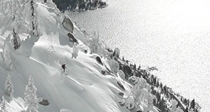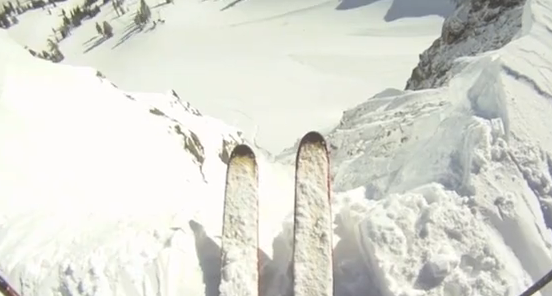By Susan Schnier
Cranking down my buckles under 20-degree bluebird skies, I prepared to drop into 3,000 feet of new, untouched powder. A familiar frenzied rush was upon me again as I crossed the boundary line marked “Esqui Extremo–Daredevil.”
The pitch was significant, and without the adrenalin pumping through my veins, I might have been nervous, but there was no time for that. My tracks became only the second to mar the slope that day. The turns were sublime, the conditions surreal. The run was so long, and the powder so deep, that I considered stopping mid-way down. But with post-season legs and the exhilaration of the epic conditions—not to mention the powder hounds riding the lift directly above me—I embraced the burn and refused to stop.
“Not such as big deal,” you might think. “Could be me on any given day between December and April,” you might say. Except, it was the beginning of July, and I was in Las Leñas, Argentina, breathing the cold, dry air of the jagged Andes, and celebrating an unusually good start to the Southern hemisphere’s ski season.
When I had left Tahoe several days earlier on the summer solstice, temperatures were well into the 90s and wildfires were consuming the once-forested hills between Truckee and Reno. Summer had officially set in, and only a few patches of snow were left in places like Shasta and Hood. But now winter was in full swing again.
I learned the basics in high school, but until now I hadn’t cared much about the earth’s rotation and the effects of gravity. Yet, all of a sudden, at the summit of Las Leñas, they became a lot more interesting as the possibility of an Endless Winter appeared. They meant that while the Northern Hemisphere rotates closer to the sun in June, forcing most North American skiers to hang up their skis for good, the snow is just beginning to fall in the high mountains of South America.
Though the journey to Argentina was long, time and space dissolved during the pilgrimage, and the final destination became my sole focus. We left the States from Atlanta around 10pm, and after an overnight flight, arrived in Buenos Aires in the morning. So far we had not even lost a day.
From Buenos Aires we boarded a domestic flight for the two-hour trip to Malargue, a small town with desert plains reaching out in every direction toward the high mountains that encircle it. Except for the 30°F temperatures, we could have landed back in Nevada and the landscape wouldn’t have given it away.
From Malargue, a festive bus ride up a narrow canyon took us high into the mountains to Las Leñas, only about an hour outside of town. As we approached the base village, we couldn’t Crossing the boundary into “Daredevil” see a thing. Night had fallen and snow and wind were pounding the mountains. There was nothing to do but sleep. Our first morning in Las Leñas presented us with blue skies and a foot of new snow.
To get an idea of the terrain and the layout of the village, picture Las Leñas as the Alta of South America. It has the steepest and most technical terrain of any of the more than seven ski areas that stretch from north to south along the Chilean/Argentinean border. Located at the end of a long, winding canyon road, there is no town to speak of, just a handful of hotels, a casino and a couple of ski stores. The skiing, rather than the mountain culture or the nightlife, is what it’s all about.
In Argentina, the ski season starts in mid-June and lasts until September, with July and August as the most reliable (and crowded) months. Though there are enough moderately pitched, groomed runs for the intermediate, the secret to Las Leñas lies in its lift-served off-piste (ungroomed) and open boundaries. In terms of longer tours and pure backcountry, you just have to look up from anywhere in the valley and scout lines in the many skiable bowls or chutes. With some Spanish skills, you may even be able to obtain pointers from one of the guides, easily spotted by their neon yellow jackets.
Open Boundaries at Las Leñas
In Argentina, like in Europe, ski area boundaries are open and you will not encounter any resistance when crossing them. Unlike in Europe, however, much of the winter backcountry in Argentina remains untracked, not because it is too dangerous, but rather because it has not yet been explored.
The possibilities are truly endless. Reaching the summit of Las Leñas takes 45 minutes on three double chairs. It is likely to be quicker and certainly warmer if you walk or skin to the base of the Marta lift (approximately 1,000 feet elevation gain). On our first day, as we rode the Marta lift under clear skies, the off-piste run, “Daredevil,” taunted us from below. Coated with a foot of fresh snow, the 2,586 foot, out-of-bounds pitch directly below the lift would become our warm-up for Las Leñas’ open boundaries.
Daredevil
From the summit, Daredevil begins as wide bowl with a few skiable chutes higher up the ridgeline on the skiers’ far right. Half way down, the bowl funnels into two separate couloirs. On a powder day, the couloirs attract snow like magnets. But beware, though Daredevil seems benign enough from the chair, less skilled skiers have been killed there on multiple occasions.
Though the run is directly under the chair, it is technically out-of bounds. On an icy day it is easy to lose an edge and tumble into the rocks atop the dog-leg chute to the skier’s right. That said, if you take the proper precautions and get up bright and early, do not miss out on Daredevil.
Eduardos
Once Daredevil got tracked, we rode the Marta lift again, got off to the right, and traversed around the ridge to Eduardo’s. We dropped into the narrow entrance and veered right, heading up to a narrow opening between two large rocks. From there, the terrain, which seemed to go on forever, was pretty straightforward—there was nowhere to go but down. We emerged after a short trek, having skied another 3,000 feet of powder, onto a groomed run leading down to the base. Though both of these runs are fairly easy to locate from these directions, we got some help on our first day from Las Leñas local and guide-extraordinaire, Diego Lopez.
Guides at Las Leñas are not cheap, costing between $57 and $200 per person per day (depending on the size of your group), but they’re a pretty good idea. They’ll help to evaluate safety hazards and offer recommendations for the best routes. Much of the terrain at Las Leñas is rocky and avalanche prone, so evaluating the terrain carefully is important. In any event be sure to carry avy equipment, and definitely wear a helmet.
The Necklace
For some wide-open bowl skiing, Cerro El Collar (the Necklace), is a 45-minute hike from mid-mountain. To access it, veer right from the top of the Marta lift, and go down the piste (groomed) Apolo run. Midway down, directly under the steep couloirs to the right, turn right off the trail and trek upward—winding up the side wall of an open bowl and then up a final lip. There, an expansive basin spreads out below. It was early season, so we stayed in the center of the bowl to avoid the many jagged rocks that line the edges. The bowl funnels into two chutes before opening up again and meeting up with a groomed area near the base of the Neptuno lift.
For the most part, Las Leñas’ locals are baffled by the very notion of hiking. With a summit elevation of 11,155 feet, Las Leñas has seemingly endless amounts of terrain. Yet, many of the lifts service only the moderate, intermediate runs, which most Argentineans like to ski. Argentineans come to the mountains to improve their skills onpiste, or to lounge and be seen at the restaurants, bars and discothèques around the village. So, there is little competition for the right to make virgin tracks down the hike-to terrain. After a full day of powder skiing, as we sat at the base, we overheard a local couple pointing up toward our tracks. Their facial expressions said it all, although the only word that we could make out was “loco.”
Other Ski Options
After two awesome days at Las Leñas, no one in our group wanted to leave. We couldn’t imagine that the skiing could get any better elsewhere, but there was more to see and we all conceded that we should move on. With a great deal of regret that our stay at Las Lenas was so short, we returned to Buenos Aires, from where we headed to Bariloche, a ski town nestled in the Patagonia range.
Bariloche
If Las Leñas is the Alta of South America, then Bariloche is the Tahoe. Situated around a large, sapphire lake, and surrounded by mountains, the town of Bariloche offers extensive shopping, fine dining and a rocking nightlife. Several ski areas, built into the Patagonia range, are within a 20-minute drive from town. Two of the main areas, Catedral and Alta Patagonia, share the same mountain yet are separately owned and require different passes.
Board the chairlift through a mall at the base of the two areas, and then ride to the treeline, where vast open slopes stretch out below. Most of the lift served skiing is on-piste, and extreme carving is still popular among local guides and instructors. Off-piste opportunities require short (20-minute) hikes from the summit and are mostly open-faced pitches. The views of the Patagonia range are truly stunning, and most of the surrounding mountains are begging to be skied, though off-piste opportunities at Bariloche are more limited than at Las Leñas. On a good day you can hike anywhere that you can see, or ask a guide for recommendations. Have lunch at the top of Catedral, where you’ll be surrounded by a panorama of jagged snow-covered peaks, and feel like you’re at the top of the world.
Buenos Aires
On our way home to North America we spent the obligatory few days in Buenos Aires. Walking around town with sun-reddened faces, tingling legs, and not-so-fresh clothing, we felt somewhat out of place among the Portenos, or inhabitants of Buenos Aires, who seemed to be some of the most well-dressed and sophisticated people in the world.
There we bought batteries for our cameras, and had a few nice meals. In a day and a half, we crammed in one seductively captivating tango/dinner show, a walk through the filigree tombs at the Recoleta cemetery where Eva Peron is buried, and a drive through the diverse “barrios” of this European- style city.
Economy
As we go to press, reports of economic and civil unrest have rippled throughout the
news, and Argentina is on its fifth president in the past two months. As of last summer the Argentinean Peso was equal to the US Dollar, but recently the Peso has been devalued by 30%. Though the political climate may be volatile, travel companies continue to encourage travel to Argentina, and if you are on a tight budget, now is actually the best time to go.
The Return
Though July is still early in the Argentinian ski season, we lucked out with plenty of powder. Our hosts, guides, and new friends made sure that we didn’t miss out on the best snow or the hottest nightclub, tolerating our broken Spanish or using English for our benefit. We could even drink the water in our sister continent. Returning to the burning forests and unrelenting heat of a California summer, I reflected on the wonder of that delicious taste of winter in July. The experience was surreal, and it certainly helped to get me through waiting for the first of our snows to fall in October.
The only question is, will summer here ever be the same again?
• Lift tickets: $30 to $40 at Las Leñas and $21 to $44 at Catedral Alta Patagonia
• Airline: Delta Airlines, red-eye from Atlanta to Buenos Aires
• Hotels in Las Leñas. The Piscis hotel features a pool, hot tub and sauna, two restaurants (Italian and traditional Argentinean), and a casino. In Bariloche, the
Llao Llao hotel is a world-class resort/hotel that is definitely worth seeing, even if you can’t afford to stay there. Bariloche also has many reasonably priced hotels on its main streets. There are also several hotels at the base of the mountain.
• Web: laslenas.com & catedralaltapatagonia.com
•Package Deal:Moguls Mountain Travel at www.moguls.com




Recent Comments